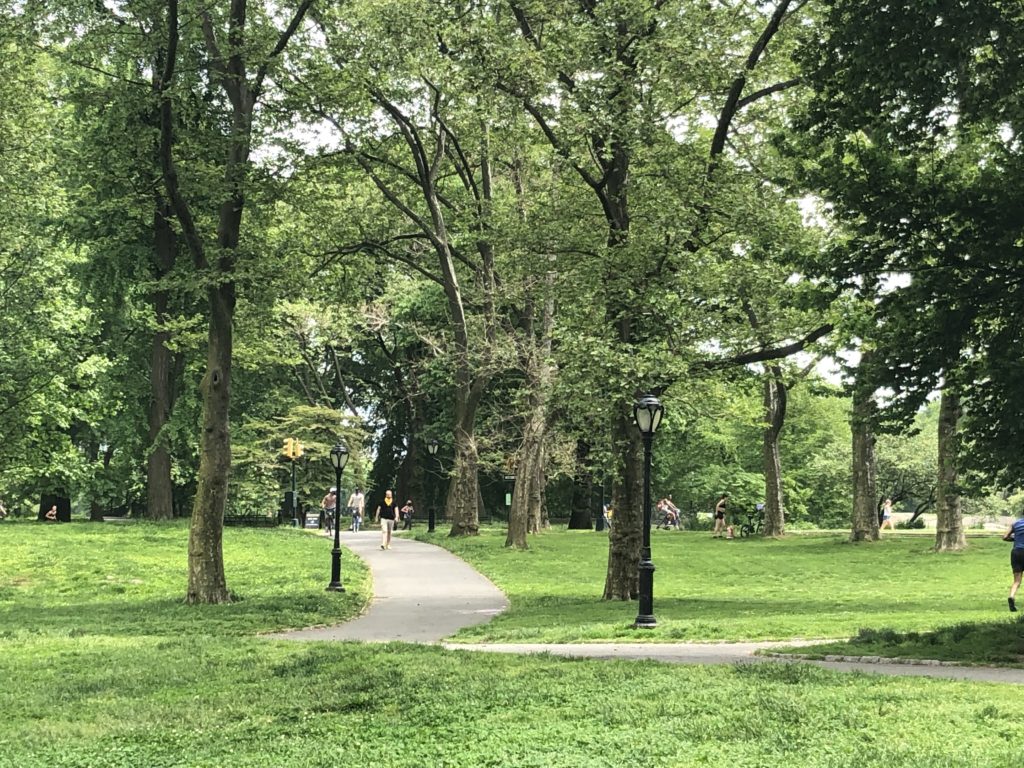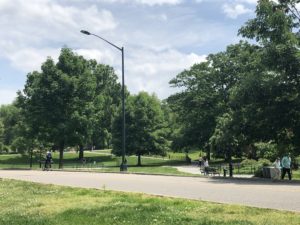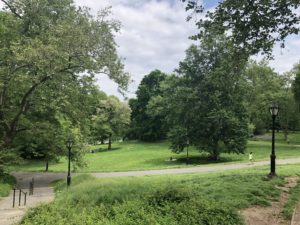Monthly Archives: June 2020
News
Going outside or staying indoors? How this choice impacts individual well-being

SRN-affiliated researchers have received NSF RAPID funding to study this question, using multiple methods to understand the complex relationships between subjective well-being, green space access, and perceived risk
A team of SRN-affiliated researchers at Columbia University, and their colleagues at Barnard College, have received funding through the NSF RAPID program to expand their research on well-being and green space. As states began mandating social distancing or issuing stay-at-home orders in mid-March, 2020, residents were instructed to stay indoors whenever possible, avoiding contact with people and going outside only for exercise and essential errands. At the same time, this team began wondering—what impact was this necessary directive having on individuals’ subjective well-being?
Utilizing NSF’s Rapid Research Response funding mechanism, which allows for the swift approval of grants in response to disasters and similarly fast-moving events, researchers at Columbia University and Barnard College have designed a study to explore the connections among green space, perception of risk, and well-being in times of a public health emergency that require people to stay indoors and isolated (grant #2029301). Numerous studies, including research by SRN affiliates, have shown that exposure to green spaces has a positive impact on the well-being of city residents. While risk of COVID-19 infection is a very real concern, and social distancing an appropriate response, how do these necessary measures affect individuals’ subjective well-being? Do people in different locations—some with access to a private yard, others with only a neighborhood park to walk to, others who have no green space they can access at all—experience different impacts to their well-being? And what role does the perceived risk of going outdoors during the COVID-19 pandemic play in the associations between green space access and well-being?

This study combines online surveys conducted during the height of quarantine measures in the US with follow-up video interviews. Researchers are conducting this research with college students, as these students have traveled home from their campuses, returning to a wide variety of residential and landscape forms. This gives researchers the ability to conduct comparative study of how access to green space influences responses to current conditions and well-being. The survey, distributed via email, includes questions about well-being, outdoor activity, risk perception, and personal responses to social distancing measures. Interviewees, solicited from survey participants, are asked questions about available outdoor green space and activity, lifestyle changes in response to COVID-19 and their effect on well-being, the role of outdoor activity in subjects’ well-being, and barriers to outdoor activity under present circumstances. Both statistical analyses and qualitative coding analyses will be used to determine (a) subjects’ access to different types of green space; (b) subjects’ willingness to utilize green space with respect to type, accessibility, and risk perception; and (c) the association of (a) and (b) with subjects’ well-being during the pandemic.
As of this writing, the survey portion of the study has been completed, with 1000 surveys submitted between April 15 and May 15, 2020. Interviews with participants are ongoing, and analysis of survey data is beginning. Preliminary results suggest that going outdoors has a positive effect on well-being. On a scale of 1–10, participants’ mean well-being at time of survey was 6.3 (SD=1.8), their overall well-being was 7.3 (SD=1.7), and their well-being during their most recent trip outdoors was 7.9 (SD=1.6). Respondents were making an average of 4.9 trips outdoors per week (SD=1.5), with the four most common destinations being their neighborhood (28.5%), a public park or garden (17.4%), a store (15.3%), and a private yard or garden (14.6%). When asked to rate how risky they perceived going outdoors to be, only 3.4% chose “very risky, people should not go outside,” while 27.2% considered it “risky, people should limit their time outdoors.” Half of respondents selected “somewhat risky,” and 19.4% chose “not risky at all.”

The research team is currently cleaning the survey data in preparation for a range of statistical analyses. Interviews are scheduled to continue through June, with transcription and coding set to follow. When analyses are complete, we plan to publish our results in a series of research papers, and also hope to be able to inform current and future preparations and responses to pandemics and other extreme emergency circumstances through recommendations on outdoor recreation, well-being, and current and future planned GI design.
Project Personnel: Megan Maurer (Columbia University, SRN affiliate), Elizabeth Cook (Barnard College), Patricia Culligan (Columbia University, SRN affiliate), Brian Mailloux (Barnard College), Ben Orlove (Columbia University, SRN affiliate), and Liv Yoon (Columbia University).
News
Sustainable Healthy Cities Network, ICLEI USA partner with Metropolitan Council to Develop Regional Climate Action Tool
The Sustainable Healthy Cities Network and the Metropolitan Council, the regional government agency for the Minneapolis-St. Paul metropolitan area, are partnering to develop a first-of-its-kind scenario planning tool to support regional climate action planning incorporating future technologies including autonomous vehicles, dynamic ride-sharing and low-carbon energy pathways.
Researchers will work with the Met Council on the project, which will provide baseline data on greenhouse gas emissions and scenario planning tools needed to track progress and inform decision-making by local governments at the regional scale, focusing largely on questions of land use and transportation planning. It represents part of the Council’s Metro Climate Stats initiative to formalize the collection, distribution, and use of greenhouse gas (GHG) data for comprehensive low-carbon planning in 188 communities in the seven-county Twin Cities metropolitan region.
The project brings together researchers from the NSF-supported Sustainable Healthy Cities Network, as well as those affiliated with a grant from NSF’s Smart and Connected Communities. ICLEI USA, a national membership organization of local governments for sustainability, and LEIF LLC, a sustainability consulting small business, are also core partners on the project.
The overall team offers a unique combination of technical and policy expertise to facilitate the development of a state-of-the-art multi-sector low-carbon scenario planning tool, as well as policy-relevant guidance to help a wide range of stakeholders and communities understand the implications of the results generated by the tool. The project is led by Professor Anu Ramaswami at Princeton University, who is the lead PI and director of SHCN, and brings expertise in urban GHG accounting, including advanced analysis of land-use related emissions as well as cross-sector circular economy planning addressing waste to value opportunities. She also co-directs a Smart and Connected Cities project, which has a particular focus on equity in urban infrastructure planning. SHCN co-PI at the University of Texas at Austin, Kara Kockelman, is a leading authority on urban transportation modeling, incorporating disruptive mobility technologies. Frank Douma, of the State and Local Policy Program at the University of Minnesota’s Humphrey School of Public Affairs, will work with the SHCN team at Princeton to develop a broad policy and stakeholder engagement plan to help ensure that the tool is applicable and useful for as many communities as possible across the Twin Cities metropolitan area.
Ramaswami, director of the Sustainable Healthy Cities Network and professor of civil and environmental engineering at Princeton University, has previously collaborated on climate action planning efforts with individual cities, and she was part of a team of experts convened by ICLEI USA to develop the first US Community Protocol for Accounting and Reporting of GHG emissions.
“This is a really exciting project, offering the chance to do something quite new in terms of climate action planning at this scale, with the potential to support action in so many communities,” says Ramaswami. “The work will make a real difference across the Twin Cities metro area, but will also help develop new national standards of best practice for doing climate action planning at the regional level. The Met Council is positioning themselves as a real leader in this space.”
“The increase in regional climate action is a welcome and needed trend. Linking communities that lack the capacity to act on their own with communities that have advanced individually improves results for all,” said Angie Fyfe, executive director of ICLEI USA. “We are excited to contribute to this project and repeat the work in other regions across the country.”
The Metropolitan Council is the regional government agency for the Twin Cities metropolitan area. Centered on the cities of Minneapolis and Saint Paul, the area is made up of the seven counties of Anoka, Carver, Dakota, Hennepin, Ramsey, Scott and Washington. The metro area is home to 3 million people in 7 counties and 188 cities and townships, encompassing nearly 3,000 square miles. Created by the Minnesota Legislature in 1967, the Council fosters efficient and economic growth for a prosperous metropolitan region.
The Sustainable Healthy Cities Network is a U.S. National Science Foundation-supported Sustainability Research Network focused on the scientific advancement of integrated urban infrastructure solutions for environmentally sustainable, healthy and livable cities. SHCN brings together people and projects supported by NSF’s Sustainability Research Network and Smart and Connected Communities program. SHCN works with scientists, industry leaders, and policy partners committed to building better cities through innovations in infrastructure design, technology and policy. The network connects across U.S. research universities (Princeton University, Colorado State University, Columbia University, Florida State University, Georgia Institute of Technology, The Ohio State University, University of Michigan, University of Minnesota, Purdue University, University of Texas at Austin), major metropolitan cities in the U.S. and India, as well as infrastructure firms and policy groups to bridge research and education with concrete action in cities.




